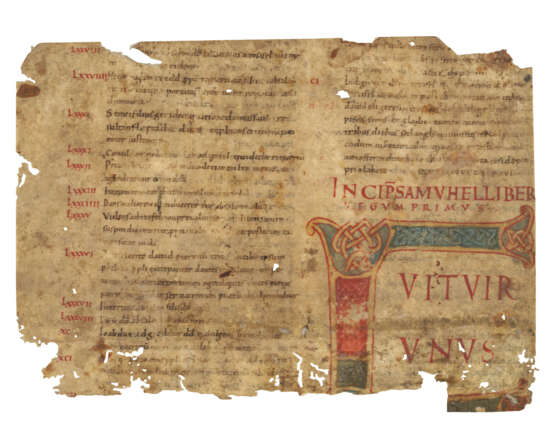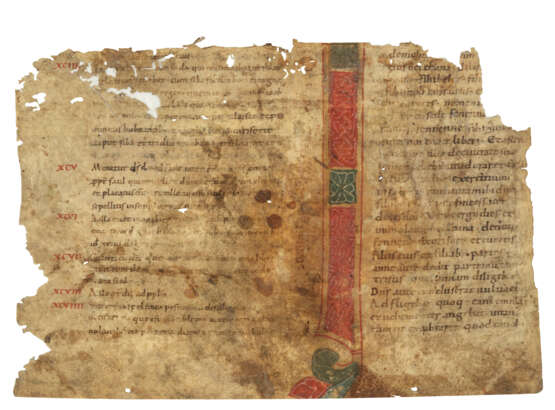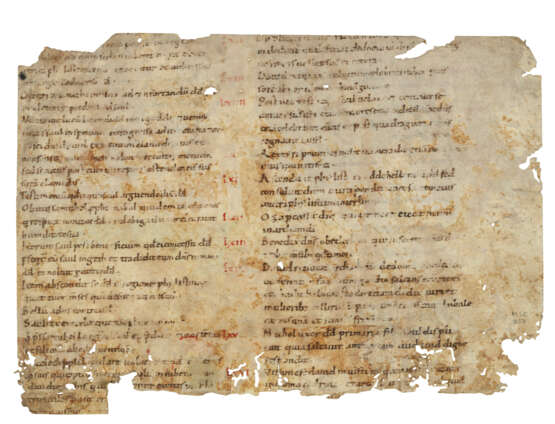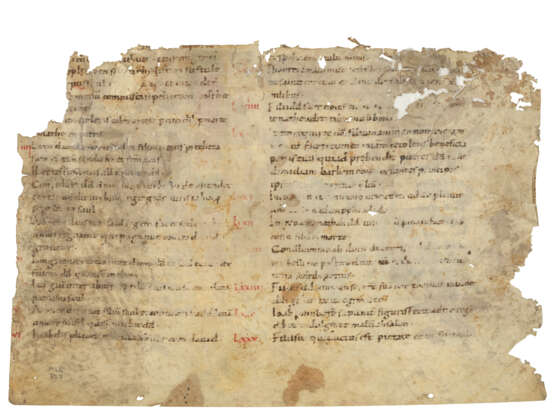ID 869422
Lot 28 | Fragments from a Romanesque Bible
Estimate value
£ 3 000 – 5 000
Two fragments of a leaf from a Bible in Latin, decorated manuscript on vellum [Italy, probably Tuscany, late 11th or early 12th century].
An imposing relic of very large-scale decoration in the ‘geometrical’ style.
Each fragment c.212 × 315mm. Each with 23–27 lines in 2 columns, written in rounded Romanesque minuscules, with a rubric and incipit in red square capitals, the text comprises the most of a capitula list for both books of Samuel, and I Samuel 1:1-6 (‘Incipit Samuhel liber regum primus. Fuit vir unus […] ut exprobraret quod dominus conclu[sisset]’), the start of the biblical book with a very large ornamental initial ‘F’ in yellow, red, and blue, with interlace and foliate ornament (recovered from use probably as the pastedowns at each end of a single volume, with significant consequent damage)
Provenance:
(1) Monumental Bibles of this sort were made in large numbers in 12th-century Italy, but would have become obsolete following the spread of the ‘Paris’ Bible in the 13th century, leading them to be eventually cut up and used as binders’ waste.
(2) Colker MS 327; acquired in 1984 from Quaritch.
In general terms the style of decoration is typical of 11th- and especially 12th-century Tuscan manuscripts of the kind studied by Knut Berg, Studies in Tuscan Twelfth-Century Illumination (1968), with the stems and bows of initials divided into panels filled with regularly repeating – ‘geometric’ – foliate or interlace ornament. The present example, with its interlace defined by lines of white dots, is especially close to Berg’s fig. 35, reproducing Florence, Bibl. Laurenziana, Plut.15.18, of the second half of the 11th century: ‘The most characteristic feature of the early geometrical initial in its canonical form is the almost exclusive use of beaded interlace as the shaft-ornament’ (p.26).
| Genre: | Religious genre |
|---|---|
| Place of origin: | Italy |
| Auction house category: | Medieval & renaissance manuscripts |
| Genre: | Religious genre |
|---|---|
| Place of origin: | Italy |
| Auction house category: | Medieval & renaissance manuscripts |
| Address of auction |
CHRISTIE'S 8 King Street, St. James's SW1Y 6QT London United Kingdom | |
|---|---|---|
| Preview |
| |
| Phone | +44 (0)20 7839 9060 | |
| Buyer Premium | see on Website | |
| Conditions of purchase | Conditions of purchase |






